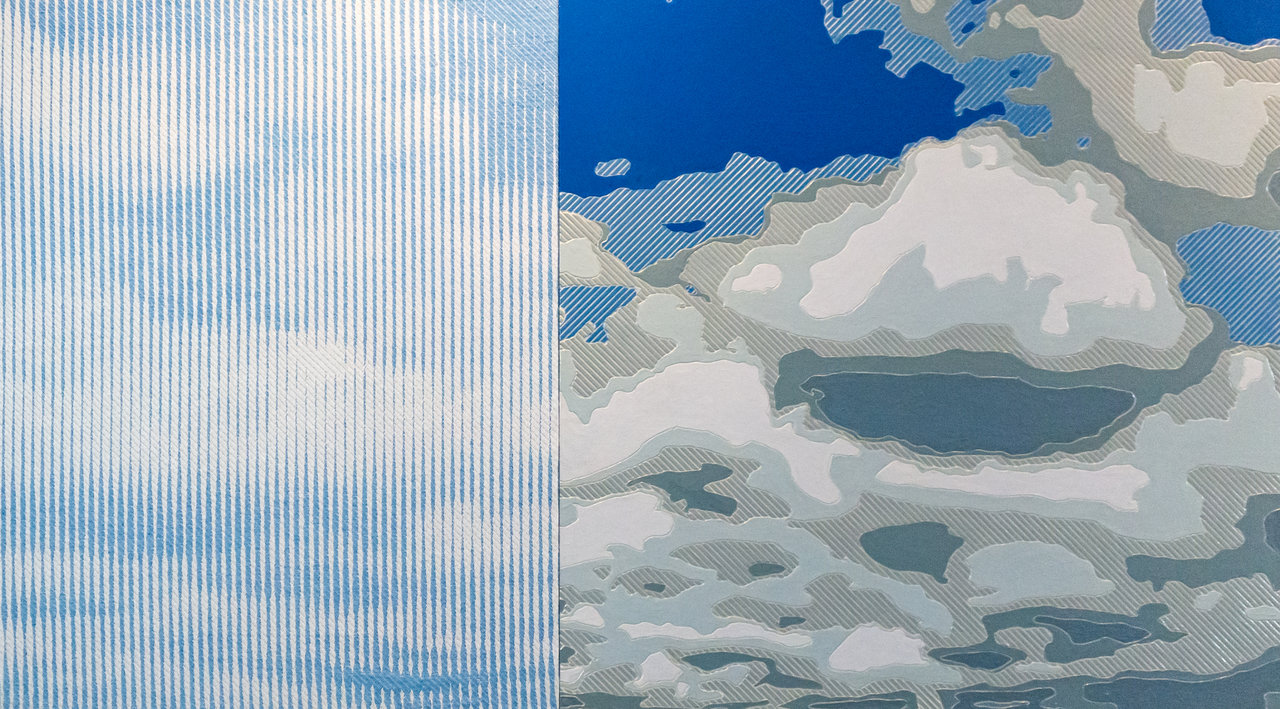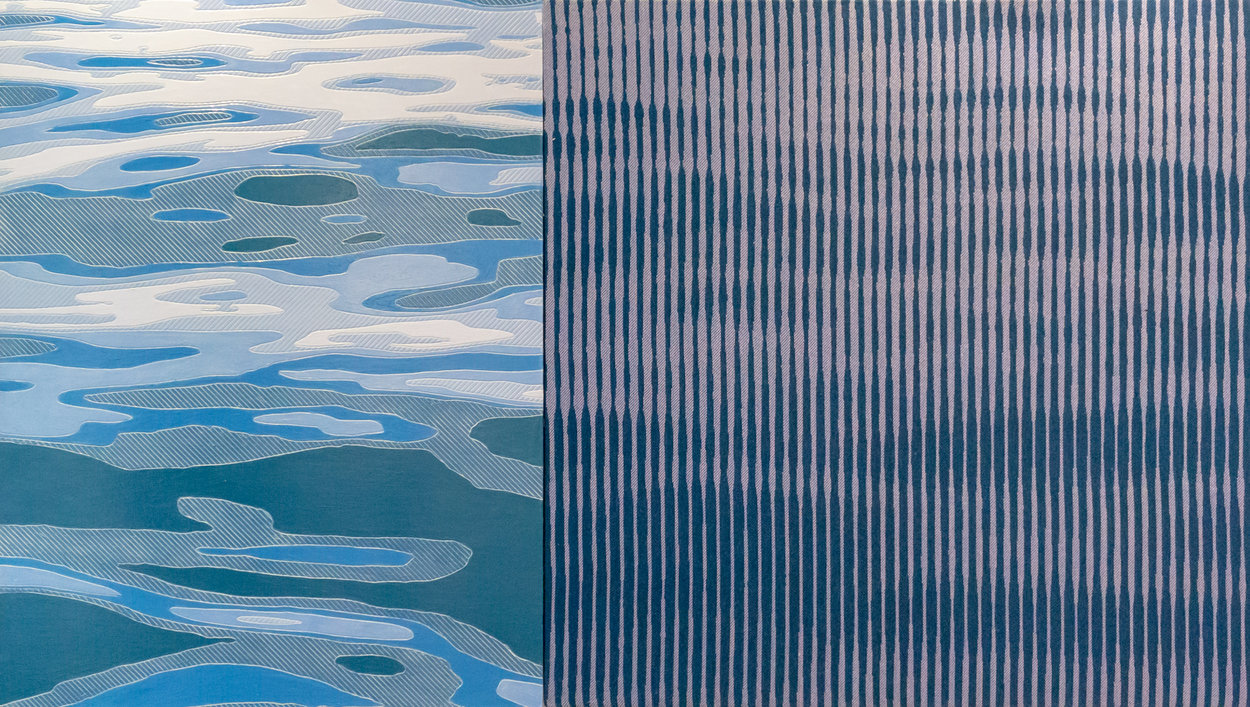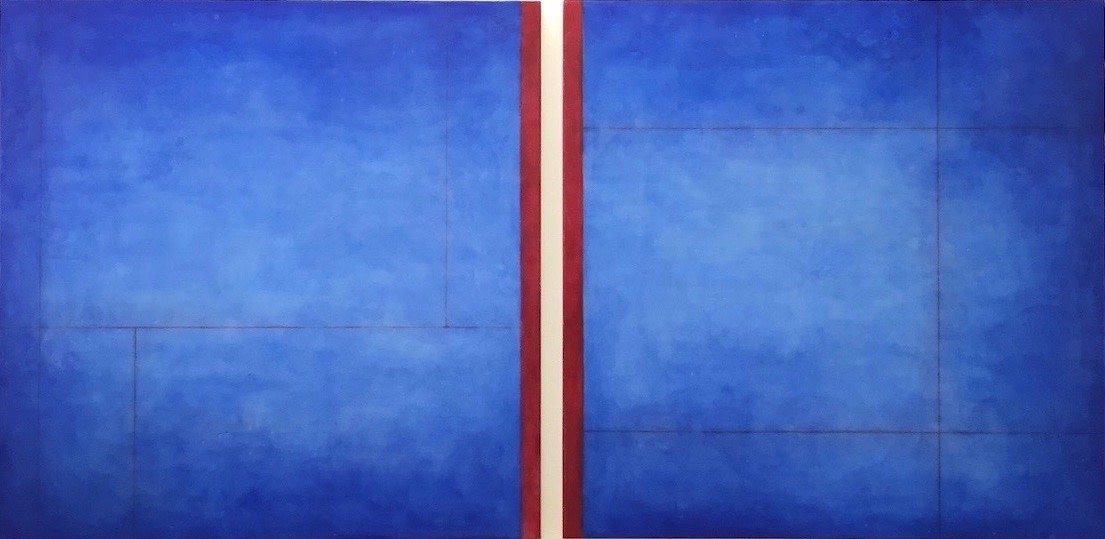The Elaine Fleck Gallery in Parkdale currently features the work of two independent artists – Mikael Sandblom and Melissa Tseng. The show is curated by Fleck herself, who chose these two artists because of their shared interest in process. On the east and south walls are displayed several of Tseng’s works, with one more in the gallery’s front window. Sandblom has six works on the west wall. In terms of technology the two artists’ works couldn’t be more disparate. Tseng’s medium is encaustics, i.e., pigment in beeswax, that dates back millennia. Sandblom chooses to design his works on the computer and employs some of the latest manufacturing technologies to render them physically. Their works nonetheless sit well together. This is in part because of the pared-down abstraction that they both embrace.
Melissa Tseng, Swirl, encaustic, 48 x 60 x 1.5 in (in the front window)
Tseng describes her paintings as minimalist. They consist in heavily worked panels, that sometimes stand singly but at other times form multiply panelled compositions. The encaustics are applied layer upon layer, with up to twenty layers in the final pieces. Tseng explains that she starts by etching marks on the wooden panel and then proceeds to cover it with translucent layers of pigment. She finishes the paintings by adding spare geometric designs consisting primarily in dots and lines. The result is a set of sensorily rich artifacts. They are reminiscent of the ancient insects and vegetation preserved inside amber. I resist calling them ‘pictures’ because they possess a vivid depth that is emphasised by the occasional imperfections on the surfaces caused by bubbles in the beeswax. Nor could they be called sculptures however. They seem flat at first glance but on closer inspection the viewer is drawn in by their subtle depth.
Melissa Tseng, Sequence, encaustic, cold wax and oil, 36 x 48 x 1.5 in
Like Tseng’s, Sandblom’s works are carefully composed of several elements. In Sandblom’s case these elements comprise machine-made tapestries and wood engravings, as well as manipulated photographic images under coloured perspex – all artfully combined. Most often there is an underlying pattern that crosses the abutting panels of tapestry and engraving which pulls the whole picture together. While the viewer easily recognises these patterns to be based on clouds and water, the original photographic imagery has been drastically pared down to its elemental forms.
Mikael Sandblom, Near To Shore, 2019, Jacquard tapestry and painted wood relief, 42 x 24 in
It is not by accident that Sandblom bases much of his imagery on water, that substance that stands somewhere between mutable and permanent It is this quality that led the ancient Greek Thales famously to postulate that everything is ultimately composed of water. It is this tension between permanence and change that fascinates Sandblom. Indeed, his principal aim is to make the viewer conscious of her own act of perceiving. As he puts it “I hope that these pieces will give a glimpse of yourself seeing, the opportunity to see the moment when your perception shifts between seeing the surface and seeing the illusion of the clouds and waves.” It is interesting that he chooses to talk of the illusion of clouds and waves. For Sandblom, talk of seeing an unambiguous reality that exists independently of our perceptions is empty. What we take to be real is ultimately our own interpretation of the world.
Mikael Sandblom, I Had It For A Moment, 2019, Jacquard tapestry and painted wood relief, 54 x 31 in
But how is this idea tenable given that it implies that we cannot see the world as such? I hazard to suppose that Sandblom doesn’t want to deny the existence of a world independent of us, as if reality is our own creation entirely. Perhaps he has in mind what Nelson Goodman calls worldmaking (Ways of Worldmaking, 1978). There is by this measure a world to be grasped, but not from some monopolistic point of view. Rather, we construct versions of the world that incorporate sciences like biology and physics, but which also include art. Reality is pluralistic in this sense. Sandblom, I think, is interested in the act of perception as it pertains to the artist’s endeavour to construct some version of the world. Thus water is not that substance out there, but rather it is that which is depicted by maps, photographs, etc. in all their glorious diversity.
Mikael Sandblom, Wide Open, 2019, Jacquard tapestry, painted wood relief and digital prints, 44 x 12 in
Similarly, Tseng is concerned with showing the viewer the process by which she creates her works. Thus the works become the manifestation of their own histories. Her version of the world is wrapped up in what the viewer perceives. As she explains, “To the casual observer, my paintings may be perceived as simple and tranquil, yet when closely examined, reveals a complex visual history of its creative journey.”
Melissa Tseng, Escape, encaustic, 36 x 72 x 1.5 in
These two artists share a sophistication of thought that is evident in these beautiful works. Fleck has done a fine job bringing the works of these two artists together.
Hugh Alcock
Images are courtesy of Elaine Fleck Gallery
*Exhibition information: September, 2019, Elaine Fleck Gallery, 1351 Queen St W, Toronto. Gallery hours: Wed – Sun, 12 – 5 pm.







A Beautifully written piece, Alcock thoroughly and artfully conveys each importance aspect of the work. A pleasure to read!